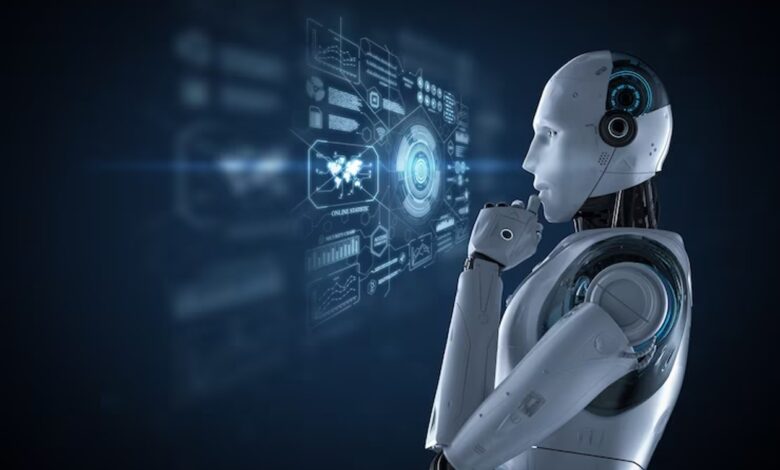The Role of AI and Robotics in the Future of Warehousing

The landscape of warehousing is undergoing a profound transformation as the integration of artificial intelligence (AI) and robotics reshapes the future of logistics. This guide explores the pivotal role of AI and robotics in the future of warehousing, unveiling a technologically advanced era that promises unprecedented efficiency, precision, and innovation.
AI and Robotics in the Future
In the first paragraph, we delve into the current state of warehousing, setting the stage for the transformative journey ahead. The focus is on the dynamic synergy between AI and robotics, elucidating how these technologies are not mere tools but catalysts driving the evolution of warehousing operations.
Streamlining Operations
Warehousing is a complex and dynamic industry that relies heavily on the efficient management of goods, from receiving to storage and delivery. The traditional methods of manual labor and paper-based systems have been the norm for decades. However, the emergence of Artificial Intelligence (AI) and robotics has brought a transformative shift in the way operations are streamlined within warehouses.
The Need for Streamlining
In a fast-paced world where customer demands are constantly evolving, warehouses are under increasing pressure to improve their operational efficiency. Inefficiencies in any part of the supply chain can result in delays, errors, increased costs, and customer dissatisfaction. This is where AI and robotics come to the rescue.
Automation of Repetitive Tasks
AI and robotics excel at automating repetitive and time-consuming tasks, which were previously done by human workers. This includes tasks such as sorting, picking, packing, and even transporting goods within the warehouse. By doing so, these technologies not only free up human workers for more skilled and value-added tasks but also reduce the risk of human errors.
Real-time Data and Insights
AI in combination with data analytics provides real-time insights into the warehouse operations. This enables the warehouse management to have a clear view of what’s happening at any given moment. For example, it can monitor inventory levels, track the movement of products, and predict when restocking is needed. This real-time data allows for quicker and more informed decision-making.
Read More: 7 Best AI Software to Jump-start Your Stock Trading Career
Improving Inventory Accuracy
AI-driven systems are incredibly accurate in managing inventory. Manual counting and tracking can lead to discrepancies and errors, which can be costly. AI and robotics offer precision in inventory control, minimizing overstock, understock, and eliminating stockouts. This accuracy not only reduces costs but also enhances customer satisfaction.
Faster Order Fulfillment
In the world of e-commerce, where customers expect rapid order fulfillment, AI and robotics play a vital role. They can quickly locate and retrieve products from various locations within the warehouse, leading to shorter order processing times. This speed is crucial in meeting customer expectations and retaining their trust.
Scalability and Adaptability
One of the significant advantages of AI and robotics is their scalability. Warehouses can easily adapt to changing demand by adjusting the number of robots or reprogramming AI algorithms. This flexibility is a significant advantage in an industry where seasonality and market changes are common.
Enhanced Inventory Management
AI-driven inventory management systems offer real-time tracking and optimization, ensuring that warehouses always have the right products at the right time. The benefits of automated inventory control extend to reducing overstock, understock, and eliminating stockouts.
Improved Safety
Safety is a paramount concern in warehousing. AI and robotics have made significant strides in enhancing workplace safety. Automated systems reduce the risk of accidents and injuries, as well as the physical strain on human workers.
Cost Reduction
One of the most compelling advantages of integrating AI and robotics is the reduction in operational costs. While the initial investment may be substantial, the long-term savings in labor and operational expenses are substantial.
Scalability
Warehouses need to adapt to ever-changing demands. Automation offers flexibility and scalability, allowing warehouses to quickly adjust to shifts in volume and product diversity.
Data-Driven Decision-Making
AI empowers warehouses with advanced data analytics. It provides actionable insights that improve decision-making processes. Predictive analytics help in forecasting demand, optimizing inventory levels, and scheduling labor effectively.
Challenges and Concerns
It’s crucial to acknowledge the challenges and concerns associated with AI and robotics in warehousing. These include potential technical glitches, job displacement, and ethical considerations regarding the use of automation.
Future Trends
The integration of Artificial Intelligence (AI) and robotics in warehousing is an evolving and dynamic field. As technology continues to advance, new trends and developments are shaping the future of this industry.
Autonomous Mobile Robots
One of the most significant trends is the widespread adoption of Autonomous Mobile Robots (AMRs). These robots can navigate and perform tasks in the warehouse environment without fixed paths or extensive infrastructure changes. They are highly versatile, capable of performing tasks such as goods transportation, picking, and even cleaning. The flexibility of AMRs allows warehouses to adapt quickly to changing operational needs.
Collaborative Robots
Collaborative robots, often referred to as cobots, are designed to work alongside human workers. They can assist with tasks that require both precision and human judgment. This trend addresses concerns about automation replacing human jobs by augmenting the capabilities of warehouse employees.
Machine Learning and Predictive Analytics
AI-driven machine learning algorithms are becoming more sophisticated. These systems can predict demand patterns, optimize inventory levels, and even anticipate maintenance needs for robotics equipment. By harnessing predictive analytics, warehouses can enhance their decision-making processes, resulting in more efficient operations.
Warehouse Automation as a Service
Warehouses are increasingly exploring the concept of “Warehouse Automation as a Service.” This approach allows companies to lease automation equipment, such as robots and AI software, instead of making significant upfront investments. It offers scalability and flexibility, particularly for small and medium-sized enterprises.
Sustainability Initiatives
With a growing emphasis on environmental sustainability, warehouses are integrating AI and robotics to reduce their carbon footprint. Automated systems optimize energy consumption, reduce waste, and contribute to a greener and more sustainable supply chain.
Human-AI Collaboration
The future of warehousing lies in the effective collaboration between humans and AI. While automation improves efficiency, human workers are still vital for tasks that require creativity, complex problem-solving, and decision-making. Ensuring seamless collaboration and providing training for employees to work alongside AI is a critical trend.
Augmented Reality (AR) and Virtual Reality (VR)
AR and VR technologies are increasingly being used for training and maintenance purposes. They can provide real-time guidance for workers, helping them navigate the warehouse and perform tasks more efficiently. These technologies are especially beneficial for onboarding new employees.
Edge Computing
Edge computing is becoming crucial in warehousing. It involves processing data closer to its source, reducing latency and improving the efficiency of AI and robotics operations. Real-time data processing is essential for fast-paced warehouse environments.
Ethical Considerations
As AI and robotics become more integrated into warehouses, ethical considerations regarding the treatment of AI and robots are emerging. Ensuring fair treatment and ethical use of these technologies will be an ongoing trend.
Customization and Integration
Warehouses are increasingly seeking customized solutions to fit their specific needs. This trend involves the integration of AI and robotics tailored to the unique requirements of each warehouse, resulting in more efficient and optimized operations.
Case Studies
Several forward-thinking companies have already embraced AI and robotics in their warehousing operations. Amazon, for example, utilizes robots in their fulfillment centers, drastically reducing order processing times and improving accuracy.
Environmental Sustainability
The integration of AI and robotics also contributes to environmental sustainability. Reduced energy consumption, efficient routing, and optimized space utilization all play a part in reducing the carbon footprint of warehouses.
Training and Adaptation
As the industry embraces AI and robotics, it’s essential to focus on workforce training and adaptation. Workers must acquire new skills to work alongside these technologies effectively.
Legal and Regulatory Considerations
The legal landscape surrounding AI and robotics in warehousing is evolving. Warehouses must navigate issues such as data privacy, liability, and adherence to industry standards.
Global Impact
The integration of AI and robotics in warehousing has profound implications on global supply chains. Companies that adopt these technologies gain a competitive edge, affecting international trade and market dynamics.
Read More:How Chatbots Can Improve Your Customer Service
Conclusion
The warehousing industry is undergoing a profound transformation, and at the heart of this revolution lies the integration of Artificial Intelligence (AI) and robotics. The impact of these technologies on the future of warehousing cannot be overstated. As we’ve seen, AI and robotics offer a multitude of benefits that extend far beyond efficiency improvements. They are shaping the industry in ways that enhance accuracy, safety, sustainability, and scalability.
By automating repetitive tasks and introducing smart algorithms, these technologies free human workers from mundane labor, allowing them to focus on more strategic and creative roles. This not only boosts efficiency but also reduces the risk of human errors, making warehouses more dependable in meeting customer demands.
Real-time data and predictive analytics are changing the way warehouses operate. They provide invaluable insights into inventory management and operational decisions. With the power of AI, warehouses can optimize inventory levels, forecast demand, and make data-driven decisions, resulting in more responsive and customer-centric operations.
FAQs
1. What is the primary benefit of using AI and robotics in warehousing?
The primary benefit is the significant improvement in operational efficiency, leading to reduced costs and enhanced productivity.
2. What challenges should warehouses consider when implementing AI and robotics? Warehouses must address potential technical glitches, workforce adaptation, and ethical concerns.
3. How do AI and robotics contribute to environmental sustainability in warehousing?
They reduce energy consumption, optimize space utilization, and enable efficient routing, all of which contribute to a reduced carbon footprint.
4. Are there any legal considerations for warehouses adopting AI and robotics?
Yes, warehouses must navigate legal issues related to data privacy, liability, and compliance with industry standards.
5. How is the global supply chain impacted by AI and robotics in warehousing?
The adoption of AI and robotics in warehousing provides a competitive edge, affecting international trade and market dynamics.











